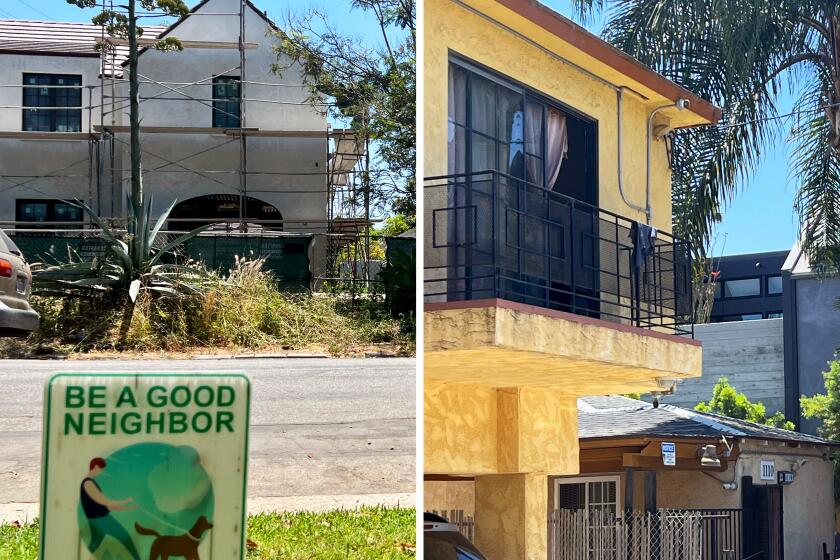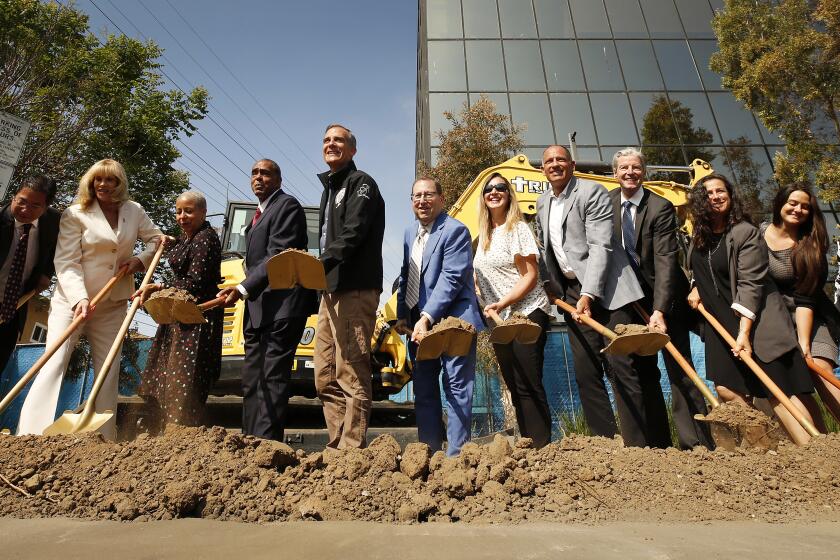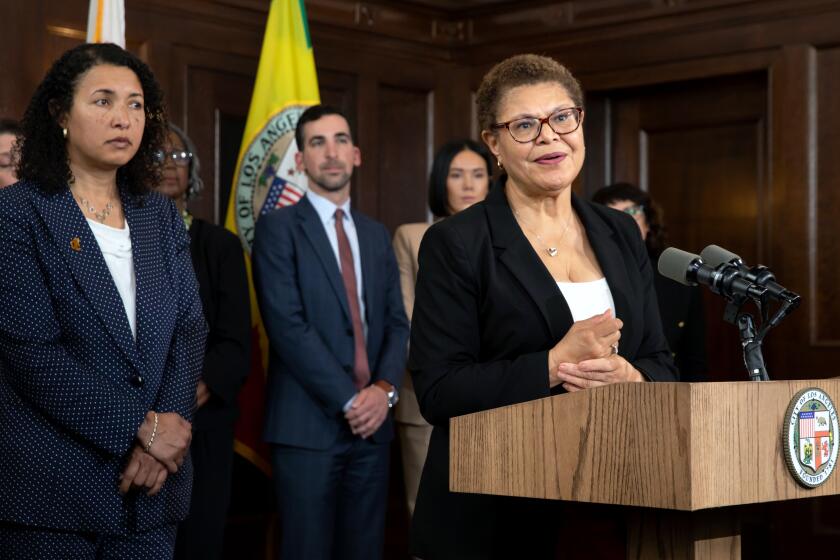Who gets to live in L.A? A bold plan to create affordable housing has a serious flaw

- Share via
Last December, Mayor Karen Bass moved to speed up the production of affordable housing in Los Angeles by issuing Executive Directive 1. This measure streamlines the approval of new multi-unit residences by exempting them from the usual slate of hearings, appeals and environmental reviews. The city Planning Commission voted this month to continue ED1, bringing the directive one step closer to becoming permanent.
On its face, this is the sort of bold housing policy Los Angeles needs. The city is not building nearly enough units to meet demand. In fact, an LAist analysis found that from 2010 to 2019, the city lost eight times more homes that were affordable for low-income residents than it gained.
This has partly been due to developers being deterred by lengthy, expensive and risky approval processes for new construction. On its face, ED1 is helping to chip away at that problem: The Department of City Planning reported that, as of the end of October, it had approved more than 50 new developments under the directive and had 55 other applications pending, projecting the addition of 12,383 new affordable homes.
Studies, and my Venice neighborhood, offer proof: Below-market rents in the corner apartment building don’t preclude a pricey mansion across the street.
But absent from this success story is the way this directive is reshaping the character and makeup of Los Angeles’ working-class neighborhoods and displacing longtime residents. In her effort to permanently streamline the construction of affordable housing, Mayor Bass is asking the city to weigh in on a bigger question: Who gets to live in Los Angeles?
According to our analysis of city data, in ED1’s first 10 months, more than a third of new developments filed under the directive have been in South Los Angeles, an area with one of the highest concentrations of Angelenos living in poverty. We also found that one-third of those South L.A. developments require the demolition of existing affordable housing, eliminating at least 62 rent-stabilized units in the area and displacing hundreds of residents, many of whom cannot afford to move elsewhere in their neighborhood or the city. Under the streamlined process, tenants have mere months to find new homes. We’ve talked to many such residents who fear they will become homeless.
It’s also worth noting where ED1 developments aren’t happening. In June 2023, Mayor Bass revised the directive to exclude parcels zoned for single-family homes — which initially made up more than half of approved projects, according to an analysis by Abundant Housing.
This change came after the city planning department heard “feedback” from residents it surveyed as well as members of the City Council concerned about apartment buildings “plunked down in the middle of single family neighborhoods.” This exemption prevents the city from streamlining the construction of affordable housing in these “higher-resource areas” with the least density. It also makes multifamily residential zones more of a target for developers.
A 2018 California housing law has helped create more than 18,000 new homes. But that’s still far short of what’s needed to dig the state out of a severe shortage.
If L.A.’s wealthy neighborhoods are preserved at the expense of low-income ones, we will all feel the consequences: rising rents as the number of rent-stabilized units continues to shrink; an increase in homelessness, especially for seniors and renters on fixed incomes who have no other housing options available; less diversity in Los Angeles as residents in the affected neighborhoods, which are predominantly Black and brown, scatter outside the city to afford rent; and more traffic as families have to relocate farther from their schools and jobs.
Los Angeles urgently needs more affordable housing, and streamlining the development process is a necessary step. But city leaders need to be mindful of what may be destroyed if the approach is not equitable. Before making ED1 permanent, the city should exempt rent-stabilized units from the streamlining process so that a more thorough assessment can take place and tenants have more time to consider their options. The city should further ensure that developers — even those pursuing 100% affordable housing projects, some of which may technically be exempt — comply with the obligations for relocation, right of return and right to remain under California’s Housing Crisis Act of 2019.
Bass has ordered the planning department to a fresh look at the process known as “site plan review,” a concept hated by housing developers in L.A.
Displaced tenants also should receive more robust relocation services, including help securing comparable replacement housing in the same area. Under the current process, the city provides a list of potential housing providers and tenants are burdened with the search for affordable units.
Finally, single-family homes should not be exempt from streamlining. Such an exemption reflects the sort of NIMBY position that got us into this affordable housing crisis in the first place. It will only reinforce the inequity that has shaped housing policy in Los Angeles as affluent neighborhoods remain relatively sheltered from change while low-income neighborhoods are dismantled for the sake of growth.
Los Angeles’ leaders must consider the unintended consequences ED1 could have. Our city has to balance the need to build affordable housing with the need to keep our most vulnerable residents and communities housed and intact. Not doing so risks undermining the efficacy of this directive, which aims to ensure more Angelenos have access to affordable housing, not fewer.
Maria Patiño Gutierrez is the director of policy and advocacy, equitable development and land use at Strategic Actions for a Just Economy in Los Angeles.
More to Read
A cure for the common opinion
Get thought-provoking perspectives with our weekly newsletter.
You may occasionally receive promotional content from the Los Angeles Times.












